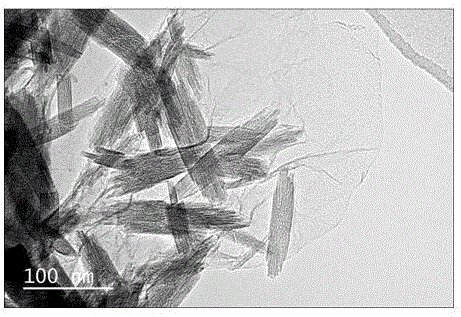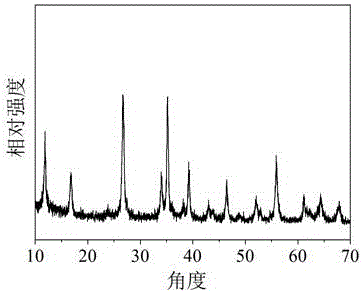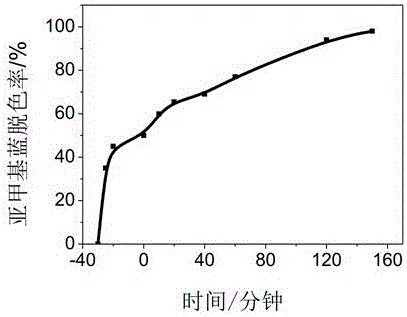Preparation method and application of beta-FeOOH-loaded graphene oxide catalyst
A technology of iron oxyhydroxide and graphene, which is applied in metal/metal oxide/metal hydroxide catalysts, physical/chemical process catalysts, chemical instruments and methods, etc., can solve problems such as limiting the application range of solar photocatalysis, and achieve Easy to separate, recycle and reuse, good application prospects, simple process
- Summary
- Abstract
- Description
- Claims
- Application Information
AI Technical Summary
Problems solved by technology
Method used
Image
Examples
Embodiment 1
[0021] The β-iron oxyhydroxide supported graphene oxide catalyst was prepared by a simple hydrolysis method. Weigh 0.1 g of graphene oxide and dissolve it in 80 mL of aqueous solution, and stir evenly to obtain a graphene oxide dispersion. Then weigh 1.1g FeCl 3 ·6H 2 O was dissolved in the above graphene oxide dispersion, the mixed solution was ultrasonicated for 60 minutes, stirred and reacted for 6 hours under the condition of heating in a water bath at 90°C, cooled to room temperature, centrifuged and washed with deionized water and ethanol for 5 times, dried in an oven at 70°C for 12 hours, and ground into powder, namely to obtain the β-oxyhydroxide-supported graphene oxide catalyst. Catalysts were stored in polyethylene bottles for later use.
Embodiment 2
[0023] The β-iron oxyhydroxide supported graphene oxide catalyst was prepared by a simple hydrolysis method. Weigh 0.1 g of graphene oxide and dissolve it in 80 mL of aqueous solution, and stir evenly to obtain a graphene oxide dispersion. Then weigh 2.2g FeCl 3 ·6H 2 O was dissolved in the above graphene oxide dispersion, ultrasonicated the mixed solution for 80 min, stirred and reacted in a water bath at 90°C for 6 h, cooled to room temperature, centrifuged and washed 5 times with deionized water and ethanol, dried in an oven at 80°C for 12 h, and ground into powder, namely to obtain the graphene oxide catalyst supported by β-iron oxyhydroxide. The morphology of the prepared β-iron oxyhydroxide supported graphene oxide catalyst was characterized by scanning electron microscopy, see attached figure 1 , β-iron oxyhydroxide is spindle-shaped and uniformly supported on graphene oxide flakes. The crystal structure of β-iron oxyhydroxide supported graphene oxide catalyst was c...
Embodiment 3
[0025] The β-iron oxyhydroxide supported graphene oxide catalyst was prepared by a simple hydrothermal method. Weigh 0.1 g of graphene oxide and dissolve it in 100 mL of aqueous solution, and stir evenly to obtain a graphene oxide dispersion. Then weigh 4.4g FeCl 3 ·6H 2 O was dissolved in the above graphene oxide dispersion, ultrasonicated the mixed solution for 60min, stirred and reacted for 8h under the condition of heating in a water bath at 90°C, cooled to room temperature, centrifuged and washed 5 times with deionized water and ethanol, dried in an oven at 90°C for 12h, and ground into powder, namely to obtain the graphene oxide catalyst supported by β-iron oxyhydroxide. Catalysts were stored in polyethylene bottles for later use.
PUM
 Login to View More
Login to View More Abstract
Description
Claims
Application Information
 Login to View More
Login to View More - R&D
- Intellectual Property
- Life Sciences
- Materials
- Tech Scout
- Unparalleled Data Quality
- Higher Quality Content
- 60% Fewer Hallucinations
Browse by: Latest US Patents, China's latest patents, Technical Efficacy Thesaurus, Application Domain, Technology Topic, Popular Technical Reports.
© 2025 PatSnap. All rights reserved.Legal|Privacy policy|Modern Slavery Act Transparency Statement|Sitemap|About US| Contact US: help@patsnap.com



